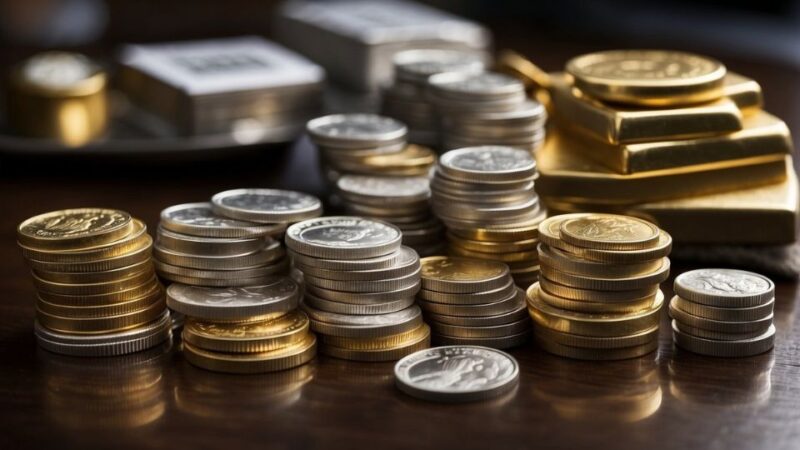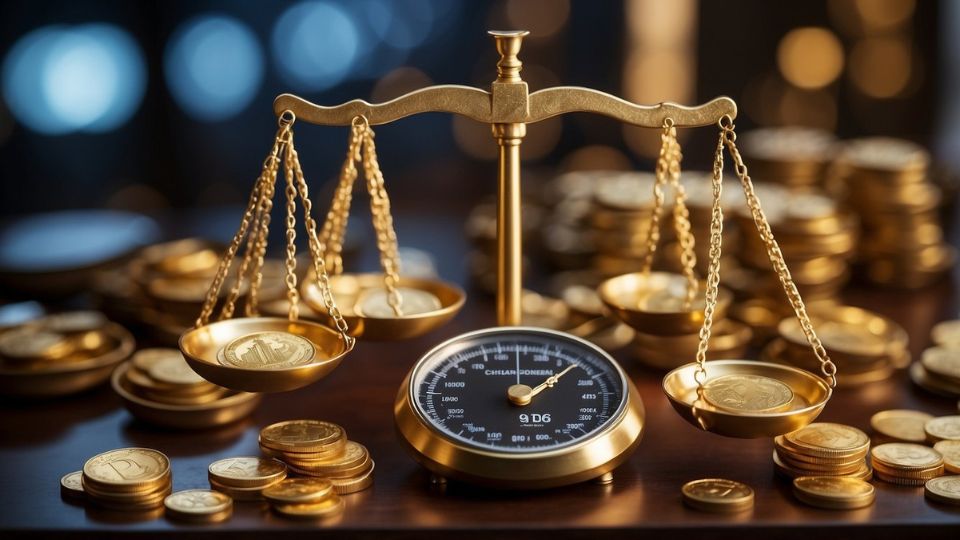Investing in gold and silver can be a strategic way to diversify an investment portfolio. Precious metals, such as gold, silver, platinum, and palladium, have historically maintained their value over the long term. This is despite the high degree of volatility in global stock markets and other financial sectors. Historically, many investors have turned to gold and silver as a safe haven to help protect their wealth during times of economic uncertainty.
Including gold and silver in a portfolio adds a layer of protection against inflation and currency devaluation. These assets are recognized for their intrinsic value and have been used as a form of currency and store of wealth for thousands of years. Their scarcity and demand across various industries, from jewelry to electronics, underpin their enduring value.
For beginners, navigating the world of precious metal investing can be daunting. Understanding how to buy, store, and sell these metals, as well as how they fit into an overall investment strategy, is crucial for success. They should consider factors like market timing, storage costs, and the form in which to hold the metals, whether it be coins, bars, or indirectly through ETFs and mining stocks.
Industry Boosts Investing in Gold and Silver
When one considers investing in gold and silver, it is crucial to grasp the various types available, their broad range of applications in multiple industries, and the market dynamics influenced by supply and demand.
Types of Precious Metals
Gold and silver are the most commonly recognized precious metals and are sought after not only for investment but also for their use in jewelry and ornaments. Platinum and palladium are less known but serve critical roles, particularly in industries such as automotive manufacturing for their use in catalytic converters which reduce vehicle emissions.
- Gold: Primarily used for investment and jewelry.
- Silver: Has applications in electronics, batteries, and jewelry.
- Platinum: Utilized in jewelry, and is also crucial in automotive catalytic converters.
- Palladium: Similar to platinum, used in catalytic converters and electronics.
Uses and Industrial Applications
Precious metals have diverse industrial applications. For instance, silver possesses excellent conductive properties, making it valuable in the manufacturing of electronics and batteries. Both platinum and palladium are essential in catalytic converters, devices fitted into vehicles to reduce harmful emissions. Outside of industry, gold and silver maintain a timeless appeal in jewelry.
- Catalytic converters: Use platinum and palladium.
- Electronics: Silver is essential for its electrical conductivity.
- Batteries: Silver is utilized due to its chemical properties.
- Jewelry: Gold and silver are traditional choices due to their luster and workability.
Investing in Gold and Silver: Supply and Demand Factors
The value of gold and silver is heavily influenced by supply and demand. Factors affecting supply include mining production and the availability of recycling. Demand is shaped by needs in industrial uses, jewelry, and the metals’ role as investment vehicles to meet various investment goals. Geopolitical stability, economic conditions, and technological advancements can also affect both supply and demand.
- Gold: High demand for investment and jewelry, with supply from mining and recycling.
- Silver: Industrial demand influences supply needs, alongside investment and jewelry.
Recognizing the distinctive characteristics of investing in gold and silver, allows for a better understanding of the intricacies of the precious metals market. In addition, investors can then make an educated appraisal of how investing in gold and silver can fit their overall portfolio.
Related: Surging Chinese Gold Demand: Market Dynamics 2033 to 2024

Investment Vehicles for Precious Metals
Investing in gold and silver offers a range of vehicles from physical ownership to market-traded products. These options cater to differing investor preferences, based on desired levels of liquidity, risk, and involvement in metals and the broader financial markets.
Physical Metals vs Exchange-Traded Products
Physical Metals: Investors often purchase bullion—bars or coins made of gold, silver, or other precious metals—as a direct investment. Owning physical metals allows investors to possess a tangible asset, but it requires secure storage and typically involves higher transaction costs.
- Advantages: Tangible assets, direct control, no counterparty risk.
- Challenges: Storage, insurance, lower liquidity.
Exchange-Traded Products (ETPs): These include Exchange-Traded Funds (ETFs) and similar vehicles that track the price of one or more precious metals. Investing in gold and silver ETFs allows investors to gain exposure to metal prices without the need to store physical metals.
- Examples: Gold ETFs, silver ETFs, and other metal ETFs.
- Advantages: Higher liquidity, accessible through the stock market, no need for physical storage.
- Challenges: Management fees, potential counterparty risk.
Understanding Mining Stocks and Mutual Funds
Mining Company Stocks: By investing in stocks of companies that mine gold and silver, investors gain exposure to the metals market through the performance of these companies. The value of mining stock tends to be linked to the price of the metals mined, although it is also influenced by company performance and other market factors.
- Traits: Affected by both the metal prices and company success.
- Considerations: Diversifiable risk through mutual funds, and potential dividends.
Mutual Funds: A mutual fund may invest in a portfolio of mining stocks, offering diversification and professional management. These funds often group various mining stocks, distributing risk across different companies and projects.
- Advantages: Diversified exposure, and professional management.
- Challenges: Management fees, less direct exposure to metal prices compared to physical metals or ETPs.
Futures and Options in Precious Metals
Futures and Options: Investors can engage in futures and options contracts for gold and silver, which are agreements to buy or sell at a future date at a predetermined price. These contracts are traded on futures exchanges and require a grasp of complex financial instruments.
- Futures: Commitment to buy or sell at a future price, leveraged positions, high potential for both gain and loss.
- Options: The right, but not the obligation, to buy or sell at a future price, less risk compared to futures.
Investment Considerations: Using futures or options provides a more advanced investment method that can hedge against risks or speculate on price movements, but it demands a deeper understanding of market mechanisms.
- Advantages: Leverage, and hedging opportunities.
- Challenges: Complexity, higher risk of significant losses.
Related: Why Gold Prices Are Now Skyrocketing Unexpectedly Over $2,250
Risks and Rewards of Investing in Gold and Silver
Investing in gold and silver can be a complex process, inherently tied to market intricacies and economic factors. Amidst potential gains, investors must navigate various risks associated with price volatility and market dynamics.
Volatility and Market Fluctuations
Precious metals, such as gold and silver, can experience significant price volatility. This volatility is often driven by changes in investor sentiment and can result in rapid price movements. The spot price, or the current price at which a metal can be bought or sold, is influenced by an array of factors, including geopolitical events and shifts in supply and demand. These market fluctuations can affect the value of an investor’s holding and must be carefully considered.
Price Determinants and Economic Impacts
Economic uncertainty often plays a crucial role in determining the prices of gold and silver. In times of financial instability, gold and silver may act as a hedge against inflation. However, they can also be susceptible to changes in industrial demand and currency values. These assets lack counterparty risk, which means there’s no reliance on a counterparty’s ability to pay, but still carry other risks like credit risk, where the creditworthiness of securities can impact prices.
- Key Price Influencers:
- Supply and demand dynamics
- Currency fluctuations
- Central bank policies
Hedging Against Inflation and Diversification
Gold, silver, and other precious metals are frequently considered a reliable method to hedge against inflation. Over the long term, they have held their value and often appreciate when the cost of living increases.
Moreover, adding gold and silver to a portfolio can enhance diversification, which helps reduce overall portfolio risk. Nonetheless, they should not be seen as a singular investment solution, and the benefits of diversification depend on the specific market conditions and portfolio compositions. Investors should balance these metals with other asset classes to manage risk effectively.
- Diversification Benefits:
- Risk mitigation
- Portfolio balance
- Long-term value preservation
How to Start Investing in Gold and Silver
Investing in gold and silver can be a strategic addition to a diversified investment portfolio. With a variety of products and methods to choose from, investors should start with clear goals and understand the various options for purchase and storage.
Related: Why Are Chinese Youth Racing to Invest in Gold Beans?
Setting Investment Goals and Strategies
Before purchasing gold and silver, investors should define their investment goals. Are they seeking long-term stability, a hedge against inflation, or potential short-term gains?
Precious metals can serve as a tangible asset in an investment portfolio, providing a counterbalance to more volatile assets. For example, one might invest in a Precious Metal IRA (Individual Retirement Account) to diversify retirement funds and provide potential tax advantages.
Determining whether liquidity is important will influence whether they buy physical bullion or look into paper forms of gold and silver.
Options for Buying and Storing Gold and Silver
Investors generally have two main avenues to acquire gold and silver: purchasing physical bullion or buying into a precious metal-backed financial product. Physical bullion comes in forms such as coins and bars. Here are popular options:
- Bullion coins: Like American Eagles or Canadian Maples.
- Bullion bars: Ranging from small grams to larger kilogram sizes.
Storing gold and silver safely is critical and can be done either at home or through a third-party depository. For a Precious Metal IRA, specific IRS-approved storage is required.

Selecting a Financial Advisor or Broker
Choosing the right financial advisor or broker is crucial for anyone new to precious metal investment. They should ensure the advisor understands their investment goals and how gold and silver fit into their overall investment strategy. The advisor can inform on market trends, and liquidity issues, and assist with setting up a Precious Metal IRA if desired.
It’s important to select a reputable broker, especially if purchasing tangible assets like physical bullion. This helps avoid counterfeits and ensures the metals are sold at fair market prices.
Considerations for a Precious Metals Portfolio
When building a gold and silver portfolio, investors should focus on strategic asset allocation, understand tax considerations, and maintain regular oversight to adjust as market conditions change.
Balancing a Diversified Portfolio
Investing in precious metals, like gold and silver, can provide a hedge against inflation and economic downturns. However, these should not overshadow other asset classes in a diversified portfolio.
A prudent mix might include equities, bonds, and commodities, aligning with the investor’s risk tolerance and investment goals.
- Equities: Growth potential but higher volatility.
- Bonds: Steady income, generally lower risk.
- Commodities: Including gold and silver, can diversify and hedge against inflation.
The allocation to gold and silver can vary, but financial experts often recommend a range of 5-10% of the investor’s total portfolio to avoid overexposure.
Investing in Gold and Silver: Tax Implications and Reporting
Capital gains tax is applicable to profits from gold and silver, treated as collectibles. Long-term gains (over one year) are taxed at a higher maximum rate compared to most other assets, typically 28%. Short-term gains are taxed as ordinary income.
For those investing through Individual Retirement Accounts (IRAs) or other retirement vehicles, rules can vary:
- Traditional or Roth IRAs: Both may allow for the inclusion of certain gold and silver.
- Provident funds: These may have different regulations concerning gold and silver investment.
Investors should keep detailed records for tax reporting and seek guidance from tax professionals to navigate the specifics.
Monitoring Investments and Rebalancing
Maintaining a gold and silver portfolio requires ongoing attention. Prices of metals can fluctuate sharply, and portfolios may need rebalancing to stay aligned with strategic goals.
- Review Periodically: At least annually or during major market events.
- Rebalance as Necessary: This might involve buying or selling parts of the portfolio to maintain the desired asset allocation.
Investors should use objective data and analysis to inform their decisions and avoid emotional reactions to short-term market movements. Leveraging professional advice or investment tools can be beneficial in keeping the portfolio on target.
Frequently Asked Questions
In this section, readers will find answers to some of the most common inquiries about beginning with precious metal investments.
What are the different ways to buy gold?
Individuals can purchase gold in various forms, such as bullion, coins, and jewelry. They can also invest in gold through exchange-traded funds (ETFs), mutual funds, and mining company stocks.
Which precious metal companies are considered the best?
The reputation of precious metal companies can vary, but some well-regarded ones include Barrick Gold, Newmont Corporation, and the Royal Canadian Mint. These companies are known for their stability, market presence, and comprehensive investment options. It is highly advisable that you conduct your own thorough research before choosing a company that fits your specific needs.
According to the Commodity Futures Trading Commission (CFTC), you should “never buy precious metals based on a cold call, unsolicited email, social media post, or infomercial.”
What are the pros and cons of investing in gold and silver?
Investing in gold and silver offers diversification and a hedge against inflation. However, these markets can also be volatile, with prices influenced by numerous factors. There’s also the cost of storage and insurance to consider for physical metals.
How can a beginner start investing in gold and silver?
Beginners should start by researching the market and determining their investment goals. They may then choose to start small, possibly with coins or small bars, or use more liquid assets like ETFs to gain exposure to precious metal prices.
Is investing in gold and silver a wise choice?
Investing in gold and silver can be wise as part of a diversified portfolio. These investments are often considered safe havens during times of economic uncertainty. However, investors should understand their risk tolerance and market dynamics before investing.
Can investing in gold and silver be profitable?
Yes, investing in gold and silver can be profitable. This is especially true during periods when there is increased demand for safe-haven assets. However, like any investment, there is no guarantee. Profitability can depend greatly on market timing and the specific metals chosen.





